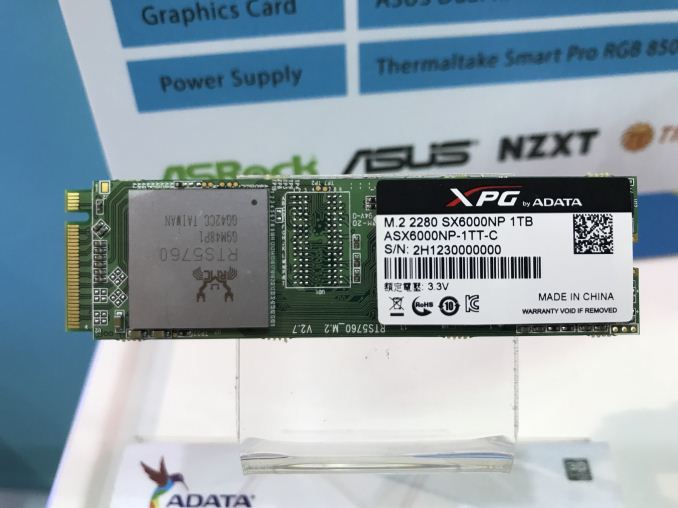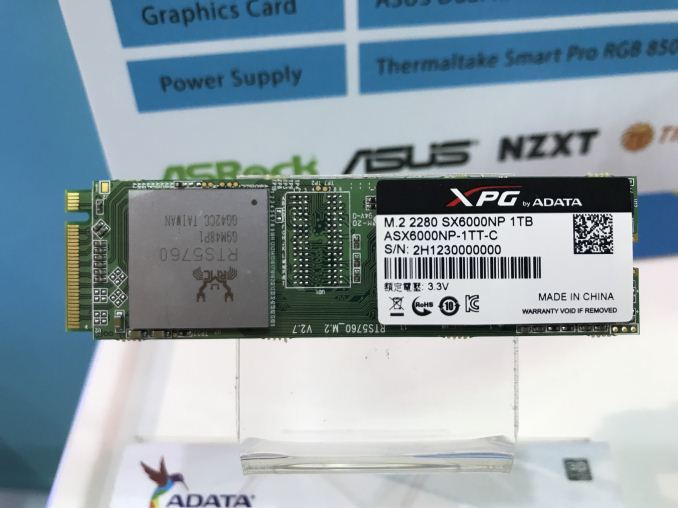ADATA Launches XPG SX6000 SSDs: 3D TLC, M.2, 512GB for $200
by Anton Shilov on October 27, 2017 7:00 AM EST
Update 11/2: ADATA notified us about the corrected MSRPs for the XPG SX6000 series SSDs, which are higher than the ones published.
ADATA has launched its new 3D TLC-based SSD, the XPG SX6000. The new drive is among the first in the industry to use Realtek’s RTS5760 controller. The manufacturer positions the XPG SX6000 SSD as an entry-level enthusiast-class PCIe x2 solution that will be affordable but will offer higher performance than the drives featuring the SATA interface.
The market of SSD controllers (unlike the market of the drives) is not very crowded, but it is still very hard to enter. Many SSD suppliers these days either use proven solutions from well-known controller designs or simply tweak turnkey designs (from Phison, Silicon Motion, etc.). Realtek announced its first generation of SSD controllers in mid-2016, but so far, no one has adopted these ICs. SSD vendors need to test how well they work with the memory they have, and since the industry is in transition to 3D NAND, sometimes they just prefer to go with proven controllers. Being one of the largest independent makers of drives, ADATA is usually among the first to adopt the latest types of memory as well as experiment with new controllers. Earlier this year the company released a lineup of SSDs featuring controllers from Maxiotek and this month it is releasing the first drives based on Realtek’s RTS5760.
ADATA has released three families of 3D NAND-based XPG-branded M.2 drives over the past several quarters: the SX7000, the SX8000 and the SX9000. The XPG SX6000 lineup complements the existing families and is aimed at the entry level of the market: it features the PCIe 3.0 x2 interface and is meant to replace SATA-based drives inside PCs for gamers with budget constraints. The interface is the limitation of the Realtek RTS5760 controller (four NAND channels, 8 CEs, PCIe 3.0 x2, NVMe 1.2, SLC caching, DRAM cache buffer support, etc.), but its performance should be enough for the particular storage devices.
ADATA’s XPG SX6000 family of drives includes 128 GB, 256 GB, 512 GB and 1 TB models. The manufacturer claims that the drives featuring 256 GB and higher capacities offer up to 1000 MB/s sequential read speed as well as up to 800 MB/s sequential write speed. As for random performance, we are dealing with SSDs capable of 100K/110K random read/write IOPS. For those who would like to ensure high performance under high loads, ADATA will ship a heatsink in the box with the drives. When it comes to endurance and reliability, ADATA rates the 1 TB version of the XPG SX6000 for 600 TBW, two million hours MTBF and covers them with a five-year warranty.
| ADATA XPG SX6000 Specifications | ||||
| Capacity | 128 GB | 256 GB | 512 GB | 1 TB |
| Model Number | ASX6000NP- 128GT-C |
ASX6000NP- 256GT-C |
ASX6000NP- 512GT-C |
ASX6000NP- 1TT-C |
| Controller | Realtek RTS5760 | |||
| NAND Flash | 3D TLC NAND | |||
| Form-Factor, Interface | M.2-2280, PCIe 3.0 x2, NVMe 1.2 | |||
| Sequential Read | 730 MB/s | 1000 MB/s | ||
| Sequential Write | 660 MB/s | 800 MB/s | ||
| Random Read IOPS | 65K IOPS | 100K IOPS | ||
| Random Write IOPS | 110K IOPS | 110K IOPS | ||
| Pseudo-SLC Caching | Supported | |||
| DRAM Buffer | Yes, capacity unknown | |||
| TCG Opal Encryption | No | |||
| Power Management | Unknown | |||
| Warranty | 5 years | |||
| MTBF | 2,000,000 hours | |||
| TBW | 75 TB | 150 TB | 300 TB | 600 TB |
| MSRP | $79.99 | $139.99 | $199.99 | $399.99 |
ADATA does not disclose what kind of 3D TLC NAND it uses for the XPG SX6000, but given the fact that the company is using a new controller, it would probably opt for familiar memory. That said, it is highly likely that ADATA uses Micron's 32-layer 3D TLC NAND, but that is something the company has not confirmed yet.
ADATA plans to start sales of the new XPG SX6000 drives with 128 GB, 256 GB and 512 GB capacity in the coming weeks at Amazon and Newegg. Other regions and the 1 TB model will follow. As for pricing, the MSRP of the entry-level model is set at $79.99, whereas the 512 GB version is priced at $199.99. The new MSRPs of the XPG SX6000 series drives make 128 GB and 256 GB versions of such SSDs competitors to the SX7000/SX8000 products from ADATA that have been on the market for a while and which actual prices have dropped compared to the original MSRPs. Over time, pricing of the XPG SX6000 will decrease, but right now such 128 GB and 256 GB drives look less competitive than the SX7000/SX8000-series SSDs of the same capacity (while the SX6000 128 GB looks good against the SX7000 128 GB, it is slower than the SX8000 128 GB, at least on paper).
| Brief Comparison of 3D NAND-Based ADATA XPG M.2 SSDs | ||||||
| SX6000 | SX7000 Gammix S10 |
SX8000 | ||||
| Controller | Realtek RTS5760 | SMI SM2260 | ||||
| NAND Flash | 3D TLC NAND | 3D MLC NAND | ||||
| Interface | PCIe 3.0 x2 | PCIe 3.0 x4 | ||||
| Sequential Read | 128 GB | 730 MB/s | 660 MB/s | 1000 MB/s | ||
| 256 GB | 1000 MB/s | 1370 MB/s | 2000 MB/s | |||
| 512 GB | 1750 MB/s | 2400 MB/s | ||||
| Sequential Write | 128 GB | 660 MB/s | 450 MB/s | 300 MB/s | ||
| 256 GB | 800 MB/s | 820 MB/s | 600 MB/s | |||
| 512 GB | 860 MB/s | 1000 MB/s | ||||
| MSRP/Actual Pricing | 128 GB | $80 | $75 | $80 | ||
| 256 GB | $140 | $110 | $120 | |||
| 512 GB | $200 | $240 | $228 | |||
| 1 TB | $400 | $460 | $500 | |||
Related Reading
- ADATA Launches the SU700 SSD Range: Maxiotek MK8115, 3D TLC, Up to 960 GB
- ADATA Launches XPG SX9000: 2.8 GB/s Seq. Read, Marvell Controller, Up to 1 TB of MLC
- ADATA Launches XPG SX8000: High-End M.2 NVMe SSD Featuring 3D MLC NAND
- ADATA Announces XPG Gammix S10: 3D TLC, SM2260, 1.7 GB/s Seq. Read, Radiator
- ADATA Announces The XPG SX7000 Series SSDs: Up to 1 TB, M.2, PCIe 3.0 x4
Source: ADATA

















21 Comments
View All Comments
Flunk - Friday, October 27, 2017 - link
I hope you guys get a review sample, if it's even remotely competitive this could be a game-changer price-wise.CheapSushi - Friday, October 27, 2017 - link
Keep in mind these are x2, not x4 PCIe lanes. But looks to be a pretty decent bulk storage drive if prices stay low. Although, QLC drives will be even better at that price wise; I think Samsung & a few others are releasing next year.cfenton - Friday, October 27, 2017 - link
Does that matter if they can hit the advertised speeds with x2? I don't think interface matters much as long as it isn't bottlenecking the drive.saratoga4 - Friday, October 27, 2017 - link
x2 is still ~ 1.8 GB/s real world for large transfers, which would be a mind blowing level of performance in a sub $100 device. Most likely though these devices won't be bottlenecked by the PCIe interface though.ImSpartacus - Friday, October 27, 2017 - link
I wonder if we'll see more 2x PCIe drives in the future with PCIe 4.0.This might not end up being such a disadvantage if they get a "2.0" revision out in the next two-ish years.
BrokenCrayons - Friday, October 27, 2017 - link
That's $10 more than I paid for a MLC SSD three months ago. When are we going to actually see cost benefits of TLC in the consumer space?Dr. Swag - Friday, October 27, 2017 - link
This is nvme thoughCheapSushi - Friday, October 27, 2017 - link
As Dr. Swag said, was your MLC SSD SATA/AHCI or NVMe/PCIe? Big difference price wise.vgray35@hotmail.com - Friday, October 27, 2017 - link
Yes, but is the NVME hardware interface really that much more complex than the SATA interface to justify the cost difference, or is the dramatic speed increase is being used to justify an arbitrarily high price for the controllers and overall product offering? And hence much increased profit margin, with price gouging based on a perceived dramatic speed increase. Greater speeds should cost significantly more even if the cost of production is not significantly more. Consumers are gullible.saratoga4 - Friday, October 27, 2017 - link
It's more expensive largely because it's new while SATA has been around for almost two decades and everyone has had controllers in production for ages.